了解社交媒体移动应用程序环境中的TMS和知识转移
IF 2.4
3区 管理学
Q3 COMPUTER SCIENCE, INFORMATION SYSTEMS
引用次数: 0
摘要
知识转移是指知识从一个来源传播,使其被接收者学习和应用,这一直是知识管理的挑战。本研究的目的是了解交互记忆系统(TMS)与知识迁移的影响因素。设计/方法/方法借鉴传播可见性、社会距离和流动理论,构建研究模型。然后,从社交媒体移动App的用户中收集数据,使用偏最小二乘-结构方程模型(PLS-SEM)对数据进行分析。研究发现,在社交媒体移动应用环境下,stms是一个有效的二阶结构,这更多地反映在可信度上。沟通可见性和社交距离对TMS均有正向影响,进而对知识转移有正向影响。心流对知识转移有正向影响。实际意义移动应用程序的开发者应该仔细考虑信息和通信技术(ICT)在支持经颅磁刺激和知识转移方面的作用。他们应该考虑推荐算法,以便保留通信可见性的好处。他们应该设计基于相似性对用户进行分类的功能,从而激发用户的近距离社交感。他们应该根据用户的整体体验不断改进功能。原创性/价值本研究结合沟通可见性、社会距离和流动的视角来理解经颅磁刺激与知识转移,为研究提供了新的视角。本文章由计算机程序翻译,如有差异,请以英文原文为准。
Understanding TMS and knowledge transfer in the social media mobile App context
PurposeKnowledge transfer which refers to the communication of knowledge from a source so that it is learned and applied by a recipient has long been a challenge for knowledge management. The purpose of this study is to understand influencing factors of transactive memory system (TMS) and knowledge transfer.Design/methodology/approachDrawing on the theories of communication visibility, social distance and flow, this study develops a research model. Then, data are collected from users of the social media mobile App. Partial least squares-structural equation modeling (PLS-SEM) is employed to analyze data.FindingsTMS is a valid second-order construct in the social media mobile app context, which is more reflected by credibility. Meanwhile, communication visibility and social distance each have positive effects on TMS which further has a positive effect on knowledge transfer. Flow has a positive effect on knowledge transfer.Practical implicationsDevelopers of the mobile App should carefully consider the role of information and communication technology (ICT) in supporting TMS and knowledge transfer. They should consider recommendation algorithm so that the benefit of communication visibility can be retained. They should design the feature to classify users based on similarity so as to stimulate users' feeling of close social distance. They should keep on improving features based on users' holistic experience.Originality/valueThis study incorporates the perspectives of communication visibility, social distance and flow to understand TMS and knowledge transfer, presenting a new lens for research.
求助全文
通过发布文献求助,成功后即可免费获取论文全文。
去求助
来源期刊

Aslib Journal of Information Management
COMPUTER SCIENCE, INFORMATION SYSTEMS-
CiteScore
5.30
自引率
19.20%
发文量
79
期刊介绍:
Aslib Journal of Information Management covers a broad range of issues in the field, including economic, behavioural, social, ethical, technological, international, business-related, political and management-orientated factors. Contributors are encouraged to spell out the practical implications of their work. Aslib Journal of Information Management Areas of interest include topics such as social media, data protection, search engines, information retrieval, digital libraries, information behaviour, intellectual property and copyright, information industry, digital repositories and information policy and governance.
 求助内容:
求助内容: 应助结果提醒方式:
应助结果提醒方式:


